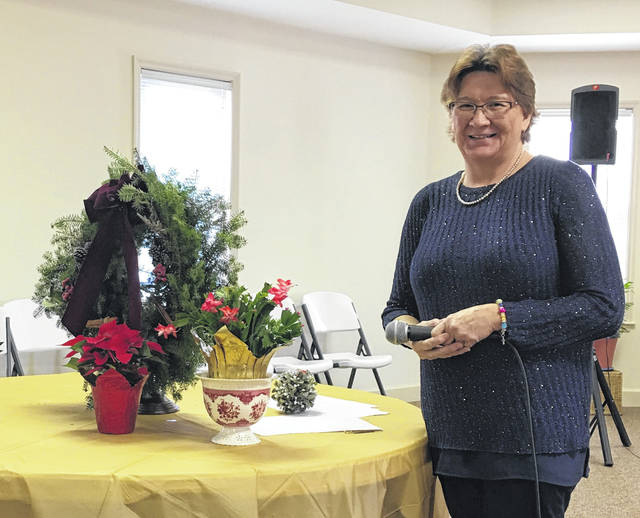
The English Club had its December meeting at the First Christian Church, with Jean Singleton and Jane Walker serving as hostesses.
When the members arrived there were warm scones and hot tea at each table. Donna Barnhart, Avonelle Williams and Nancy Bernard were the winners of the tiered Christmas plates that served as centerpieces.
The program was presented by Jean Singleton, telling us about Christmas flowers, symbols and legends.
Traditional Christmas colors are often seen in holiday bouquets and floral arrangements. Although bright and cheery, that is not why they are chosen. Red, white, green and gold originated in Christian religious symbolism relating to the birth of Christ. White – purity, innocence, and peace; Red – the blood of Christ; Green – everlasting or eternal life; Gold or Silver – the Star of Bethlehem; Blue – the Virgin Mary.
The poinsettia has become a symbol of the Christmas holidays with its green foliage topped with bright flowers. Native to the mountains of Mexico, this Christmas flower has a colorful history. According to Mexican legend, a young girl named Maria and her brother Pablo were first to discover the poinsettia. The two children were very poor and could not afford a gift to bring to the Christmas Eve Festival.
Not wanting to arrive empty-handed, the two children stopped beside the road and gathered a bouquet of weeds. When they arrived at the festival, they were chided by other children for their meager gift. But when they placed the weeds beside the Christ Child in the manger, the poinsettia plants burst into brilliant red blooms. From that day on, in Mexico the poinsettia has been known as “flores de Noche Buena” or Flowers of the Holy Night.
The Christmas cactus isn’t really a cactus at all, but is a succulent that belongs to the cactus family. It produces showy arches of flowers in shades of pink and red during the dark days of winter, giving it the name of Christmas cactus.
Holly is an evergreen shrub that produces glossy green leaves with sharp pointed edges, small white flowers and red berries. In Christian symbolism, the evergreen leaves represent eternal life, while the red berries represent the blood shed by Christ.
Mistletoe is a popular plant for decorating the home at Christmastime and is often hung in doorways. The tradition of kissing under mistletoe is thought to derive from Norse mythology.
According to one version of the legend, when Baldr the Beautiful was killed by an arrow made of mistletoe, his mother’s tears on the arrow turned into white berries which healed his wound and brought him back to life. Filled with elation, his mother then blessed the mistletoe plant and vowed to kiss all who passed beneath it.
Evergreen wreaths have a long tradition as a symbol of everlasting life. They also symbolize eternity or the eternal nature of God, with no beginning and no end. The evergreen wreath hung over a window or on the door serves as a symbol that the spirit of Christmas dwells within the home.
Members of English Club brought in infant caps and mittens for the WIC program.
President Nancy Jones wished everyone a wonderful holiday season. She reminded members that the next meeting will be March 1st with Sue Miars, Donna Barnhart and Daphne Blackburn as hostesses.
Members present were Donna Barnhart, Nancy Bernard, Sharon Breckel, Joan Burge, Barbara Davis, Beverly Drapalik, Lois Hackney, Susan Henry, Nancy Jones, Shirley Katter, Anne Lynch, Sue Miars, Judy Sargent, Jean Singleton, Helen Starkey, Jane Walker, Avonelle Williams and Nancy Williams.


